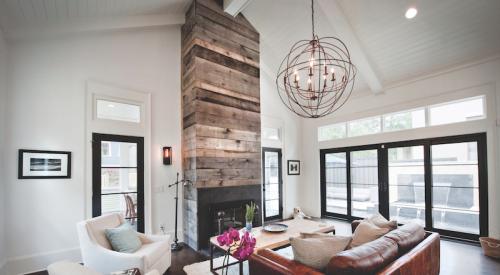Giants are using building science to differentiate themselves from regional competitors, increase market share for their divisions and to protect and increase their bottom line. Giants face serious challenges — contracting multiple trades, incorporating new construction techniques and responding to increasingly tough competition from smaller, local builders. The industry has learned a lot over the past decade about how applying building science to designing and building durable, energy-efficient homes helps Giants deal with the challenges they face, achieve a better return on their investments and increase their bottom line.
Getting Serious About Building Science  |
| By using a building science approach, Giants are designing more durable, energy-efficient homes. |
Frank Beasley, vice president of building science at Town and Country Homes, a K. Hovnanian Company, explains how applying basic building science principles are increasing the company's bottom line. "In 1996, we got serious about building science, particularly about tackling durability issues...in our Chicago division. We focused on making sure the home lasts longer than the mortgage and created details for flashing and housewrap that we can repeat in every design. We concentrated on creating a durable drainage plane for our homes to keep the elements at bay. We wanted to implement uniformly superior details in every home built in the Chicago division."
Implementing these details throughout the division was hard work, and it didn't happen overnight, says Beasley, but the work and time spent paid off. "It took us three to four years to implement our building science initiative, but in the end, we saw a 70 percent reduction in warranty callbacks in the Chicago division. Since 1996, we've reduced our warranty budget by more than 25 percent, and we've applied the accrued difference directly to our bottom line each year."
Town and Country Homes applies the whole-house building science approach to design and construction. This approach views the home as a system of parts working together to offer a comfortable, energy-efficient home. The design department takes all of the materials and systems specified in a home design and coordinates them to deliver the optimum home performance. This whole-house approach produces homes that operate at higher levels of energy efficiency and indoor air quality, making them more comfortable places for customers to call home.
 |
| By designing a home using a building science approach, Giants are able to prevent air leakage, as shown above. |
The whole-house approach is selling well in the Chicago division, says Beasley. "People with average incomes want the better built home. Most of our customers have visited competing builders in the area. We take the time to show potential customers that we're putting the latest building science technology into the design.
"When people see the difference, our credibility goes way up beyond that of our competitors. In our design center, we show potential customers cutaway drawings of the wall details that include more than the standard amount of insulation, draft-stopping details that control air leakage, and 2×6 lumber that accommodates the extra insulation. We also show them housewrap and flashing details. In short, we show the public that we're offering a durable, energy-efficient home that's built to last."
Partnering with the TradesOf course, whenever a division implements a new initiative for design and construction, management faces the challenges involved in contracting work to multiple parties. Beasley understands all too well that one of the major challenges of building better homes in any division lies in improving your partnerships with your trade contractors.
It's easy to say, "Train the trades," but how do you approach problems in the field when the quality of an installation doesn't meet your expectations? "When we have to ask a trade contractor to reinstall part of the job on insulation, ductwork, or air sealant so that it conforms to the scope of work they signed, we simply say in a respectful way, 'This is how we install the details in our division.' Our trade partners respect and appreciate the pride we take in the construction details, because building better homes helps them grow their businesses, too, not just ours." Building partnerships with the trade contractors has a ripple effect in a division, says Beasley. "We've helped the trades to reduce their callbacks. In return, they see us as their partners in building the better home."
In the Scopes and in the FieldGiants can develop partners in their quest to apply building science principles and build better homes. One such partner is Masco Contractor Services (MCS). Dave Bell, building science manager at MCS, uses the Environments For Living (EFL) program to help builders increase their bottom lines. The EFL program prescribes a set of performance-based standards for heating, ventilation, air conditioning, ductwork, insulation and air sealing. Bell explains why EFL appeals to large builders. "Giants come to us because they're dealing with a shortage of skilled trades. They need uniformity. They need a process that they can repeat in every home, in every division, that reduces callbacks and warranty claims and increases customer satisfaction ratings and referrals. Building science is the roadmap to get there. There's no way around it."
Masco's EFL program helps builders offer potential customers homes that are more durable, comfortable, healthy and energy-efficient. During the final inspection, some EFL homes are subject to a series of performance tests — for air tightness, duct tightness and pressure balance — to verify energy efficiency. "The superior installation details the builder wants are spelled out in the scopes of work for each trade. That way, each trade knows what the builder expects of them." But it isn't enough just to put what you want in the scopes of work, says Bell. "Construction managers must follow up by inspecting the field implementation." Capitalizing on the benefits of the better built home requires whole-house designs and detailed scopes of work; it also requires follow-through in the field.
Beasley explains why the industry has to pay more attention to the better built home. "While building science has been around for years, it's still new to a large enough number of people that we need to keep on teaching Building Science principles to our partners in the industry until everyone's doing it. The unfortunate reality is that not everyone in the industry is using the whole-house approach yet, and we're all paying for that reality. If we all apply the whole-house approach from design to sales to construction, then we'll all reap the financial benefits."
| Author Information |
| Michael Dickens is the CEO of BuildIQ, which provides online training on best practices in home building to help builders take their businesses to the next level of quality and performance. |












